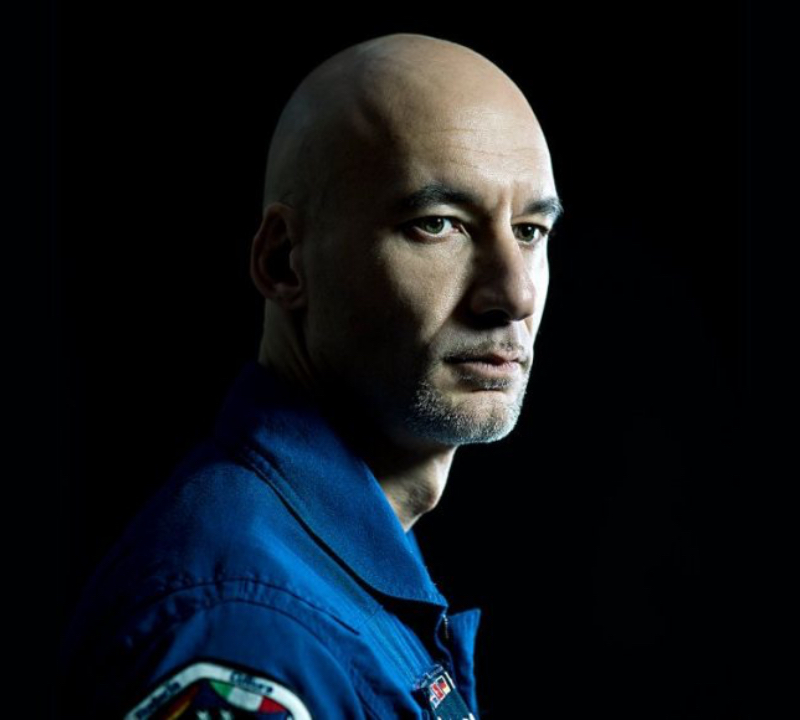Saturday, 21 August 2021 – around 14:00 hours
As I wait to board the flight that will take me back to the daily regularity of life, I look at the pictures taken and filmed during four intense days of expedition on the Gorner Glacier. They seem unreal to me – or perhaps it is the normality around me that seems surreal: people (including me) preparing to travel, eating freshly prepared food and drinking hot drinks, using the restrooms to freshen up.
Just 24 hours ago, I was ready to descend into a ‘moulin’ or ‘mill’ – the shaft created by the streams (actual rivers of melting glacier water) that carve the surface of the Grenz glacier – over 25m deep, a white canyon with bluish reflections, the bottom black in the cold shadow. I felt alive then, immersed in the moment, present: now that mill is only a few hours away, a few hundred kilometres, and what seems like a lifetime…
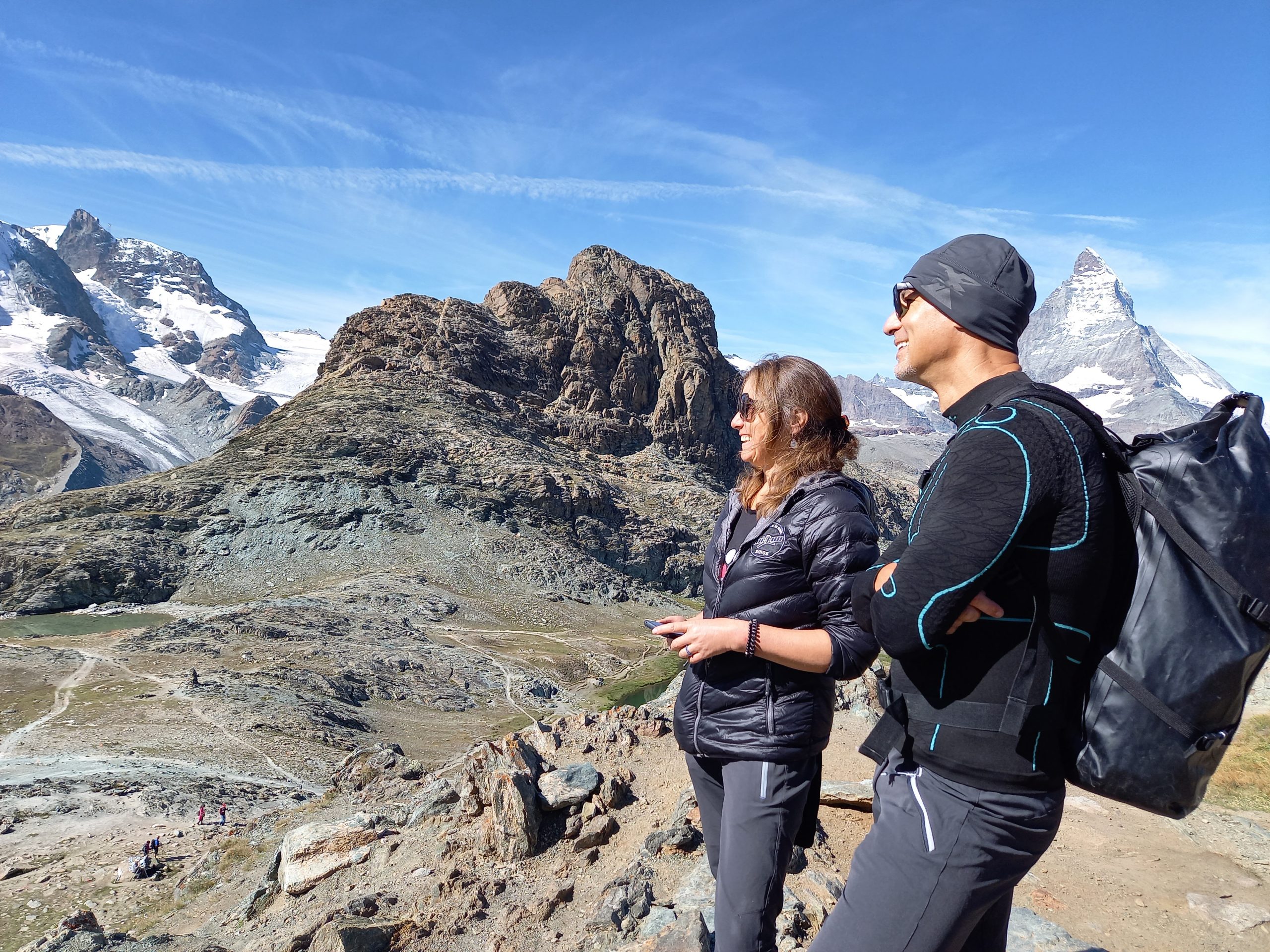
ESA astronaut Luca Parmitano and head of the ESA Climate Office Susanne Mecklenburg. Credit: ESA
Day 1 – around 11:30
The air has the crystal clear and pure freshness of high mountains or the sea breeze – in this case the former, since the unmistakable silhouette of the Matterhorn is right in front of me.
The team of scientists, video operators and logistical support is gathered in front of the small train station that has taken us from Zermatt to Rotenboden (2815 m). It’s mid-morning, and we split into two groups: one team will go down to the valley immediately, to set up the instrumentation of special exploration drones and begin as soon as possible the remote observation and mapping of some of the ice shelves on the Grenz; the second team, which includes me, will initially stay on site to allow me to talk to Professor Frank Paul from the University of Zurich, an expert geophysicist specialised in the study of glaciers. It is a unique opportunity for me to have a private – albeit extremely accelerated – lecture on what is happening in the glacier system that stands out in front of me and extends a few kilometres downstream. After a couple of hours, we start our descent towards the glacier and base camp.
The path embraces the northern side of the valley, and offers an unparalleled spectacle. Turning my gaze from right to left, the Matterhorn, the Breithorn, Castor, Pollux, Monte Rosa dominate the view upwards, but down in the valley it is the expanse of ice that captures my attention. The ice seems to be in motion, a cascade of waves pushing their way down into the valley, creating narrow canyons with walls that reflect the light and colour it blue. The sun is mirrored in it, splintered into thousands of reflections. Only the knowledge that everything I see is destined to disappear attenuates the sense of joy and wonder that pervades me as, step by step, I approach the base camp.
After about an hour and a half of walking, we veer off the path and look south, down into the valley. Alessio, one of the geologists accompanying us, knows these places intimately: this is his 23rd expedition to the Gorner, since he wrote his doctoral thesis on the glacier. “It’s been more than 20 years. The first time, from this height, we were already on the ice, then we easily descended with crampons,” he tells me. I look down, towards the white valley: there must be a difference of about 80m.
Shortly afterwards we reach an iron ladder, and one by one we descend towards the base. We put on our crampons – my first time! – and finally climb up onto the ice, then slowly cross it westbound, where our base camp is located. The Gorner has been detached from the Grenz for years now, so in order to get to the base camp, which is located on the north moraine, we first have to cross the river that is formed by the melting ice under our feet (the Gorner) and then disappears under the other glacier (the Grenz). But it is afternoon, the sun is high, and the river that our friends have easily crossed in the morning, when the melting of the ice is a little slower, is now a foaming flood, the rapids crashing violently against the rocks.
There is a ford, but it is wide and deep, so you’d have to get wet to cross it. However, I am convinced that it is possible to cross the glacier, further upstream, and then descend from the other side, directly on the southernmost side of the moraine. Paolo, a very experienced alpine guide who accompanies us, is of the same advice so the two of us break away from the group, and go up the ice slope together. And we do in fact find a segment where there seems to be a wall that leads directly to the base; but I am not equipped to do this alone. Paolo sets to work, planting three large screws in the ice to fix his rope, which I then secure to my harness. Planting the crampons in the almost vertical ice, I awkwardly lower myself to the base with the help of Paolo, who then descends nimbly on his own with the help of the ice axe. Together we continue to walk towards the moraine where we find the rest of the group, laughing light-heartedly after crossing barefoot the icy waters of the river.
After about 10 minutes we reach the base camp. A small village of tents awaits us, about a dozen of various colours and sizes. Their inhabitants had arrived hours earlier to set up camp and were happy to see us. I am assigned a tent, and I take the opportunity to unpack my backpack and freshen up. My day includes a few more interviews with Susanne, the head of ESA’s Climate Office, who explains how the Agency’s resources and satellites are being used to help us follow the evolution of the planet’s climate. When the drone team returns, having spent several hours mapping an ice cave with sophisticated instruments – lasers, lidar, video and photos – it is finally time for dinner.
The hot water is already boiling, and the freeze-dried food to be rehydrated is, not unexpectedly, familiar. Similar to what I ate on the ISS, here on the glacier it is almost comforting.
Tiredness begins to set in, especially when the sun goes down and the cold inexorably crosses the various layers of technical fabric I am wearing.
But I want to wait for the Moon to set as well as the sun. As soon as its light fades beyond the Breithorn, the sky is filled with stars, many more than I have been able to admire in the last two years. I see Saturn, followed by Jupiter, bright, clear, brilliant in the cold, crisp air. I think of an evening on the ISS when Christina and I observed Jupiter’s four largest satellites from the Cupola, visible through binoculars. I could do it from here if I had some to hand. But the memory is enough for me. I smile, and my eyelids feel almost heavy. It’s time to go back to my earthly ‘crew quarter’, the orange and white tent that will be my refuge for three nights.
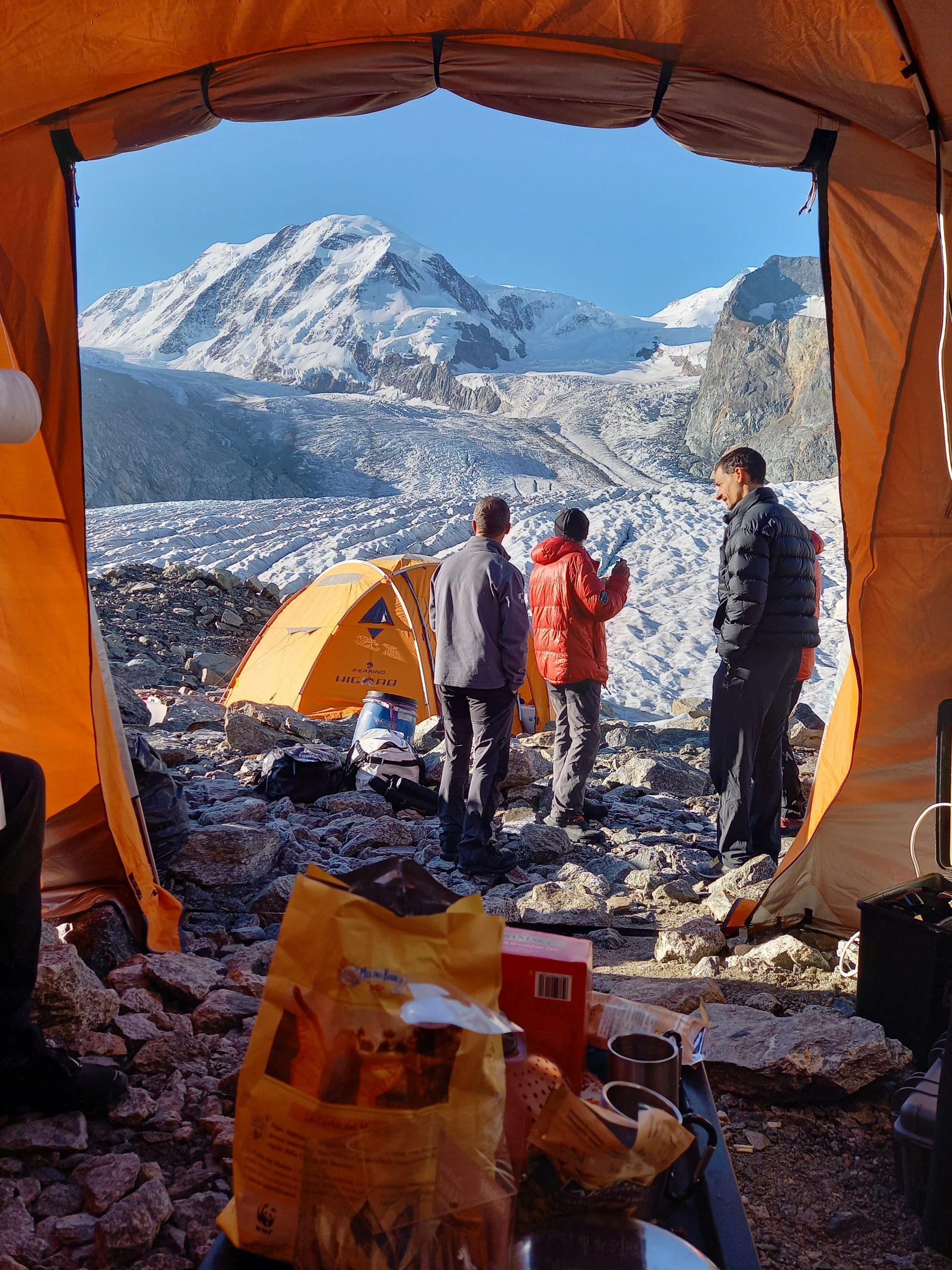
Base camp. Credit: ESA
Day 2 – around 07:30
I thought I was used to discomfort, but the cold, jetlag and especially the rocks under my back got the better of me. I got little sleep, but the cold air entering the tent gives me energy, and within minutes I am outside, ready to start the day.
An icy fog hides the camp and attenuates sounds and colours, but as soon as the sun peeps out from behind Monte Rosa the mist dissipates, and the warmth is welcome after the intense night frost.
Breakfast is spartan and quick, but the freshly brewed coffee tastes like all the mochas I’ve had the pleasure of enjoying. And maybe because I was expecting freeze-dried coffee, or maybe because the cold sterility of the ice intensifies every aroma (like on the ISS) – it seems to taste and smell even better.
The sleepy but smiling faces of my fellow expedition members gather around the tent that simultaneously serves as galley, office and meeting room. When everyone has had breakfast, our two guides, Alessio and Paolo, approach Cesco, a geologist and speleologist I have known for many years. He took me underground with CAVES and CAVES-X (in Sardinia and Sicily),and taught me field geology with PANGAEA (in the Dolomites and Lanzarote). Despite his young age, he is one of the most experienced scientists in the world, and a dear friend.
Cesco describes how to get to the first target of the day: a mill that was explored the day before with the Flyability team’s special drones. “Follow the ridges on the glacier, they are all parallel, aiming for the three big crevasses upstream, the ones that look like fingers,” Cesco points with one hand, shielding his eyes from the white reflection of the sun on the ice with the other. “Then you have to move eastwards, where you see those collapsed blocks. You will find a flat area, a canyon. Follow it and you will find the mill.”
The team of cameramen, the two guides, Susanne and I put on crampons and harnesses, and head south, crossing the width of the Grenz tethered to each other with a rope. As we follow one of the more pronounced ridges, climbing over dunes of ice, I notice the constant sound of flowing water; the glacier loses between 10 and 20 cm in height every day, between spring and autumn. An enormous volume of water, which digs the channels whose sides we climb, and then disappears into the darkness of the ice shafts that reach the base of the glacier, and then down into the valley in a whirlwind of foam.
We proceed slowly. The crampons cling to the ice with a dissonant screech, the raucous sound of metal scratching the frozen surface mingling with the much more musical sound of flowing water. As the sound increases to the roar of a waterfall, Alessio beckons us to carefully approach a crevasse – there is another mill, not the one we are looking for but no less spectacular.
The water flows perfectly clear and transparent, then vanishes into the vertical tunnel carved into the ice, beyond our sight. The video operators get their drones up in the air and slowly make their way inside the shaft, but they can’t be too daring as they risk losing visual contact with the vehicle, so they content themselves with simply filming the ephemeral beauty of the mill before bringing the drones back down and continuing our excursion.
When we arrive at the base of the glacier, the sun is already high. As instructed, we move eastwards before proceeding along one of the ridges in search of the mill explored by Cesco the day before. Alessio finds an abandoned mountaineering ice axe; the workmanship is old, the handle is wooden and perfectly preserved. Paolo looks at it with an expert gaze. “They haven’t made one like this for a long time. It could even be from the 1930s… a museum piece.” We’re all asking ourselves the same question, but no one says it out loud: what could have happened to the owner almost a hundred years ago?
The mill we are looking for seems to elude our efforts. We know it can’t be far away… but the landscape is so uniform, with dunes like waves of ice, that even if it were just a few metres beyond the ridge we are following, we might not see it.
One of the operators suggests sending the drone into the air. From above, with a bit of luck, we could find the mill and then, converging to the vertical of the drone itself, move around accordingly. Everyone likes the idea, also because it involves a little pause. The air here is thin enough to require a minimum of adaptation, and we are happy to stop for a moment. The drone lifts off and the operator begins to scan the depressions with the camera, until he finds a particularly large river. As we follow it downstream, we notice that its flow rate is decreasing, then we realise that it is actually flowing in the opposite direction. As we turn back with the drone, we see on the small screen something that could be the mill, although from above we cannot be completely sure. It’s better than groping in the dark: our target is two or three hundred metres away, and after a few minutes we find our destination.
There are two distinct wells: the first is a remnant of an older mill, the waters that dug it have found an easier passage and have dug the second, a little further downstream, with perfectly transparent blue waters that rush into the darkness at the bottom in a thunderous whirl of foam and suspended drops, creating rainbow circles when the light passes through them.
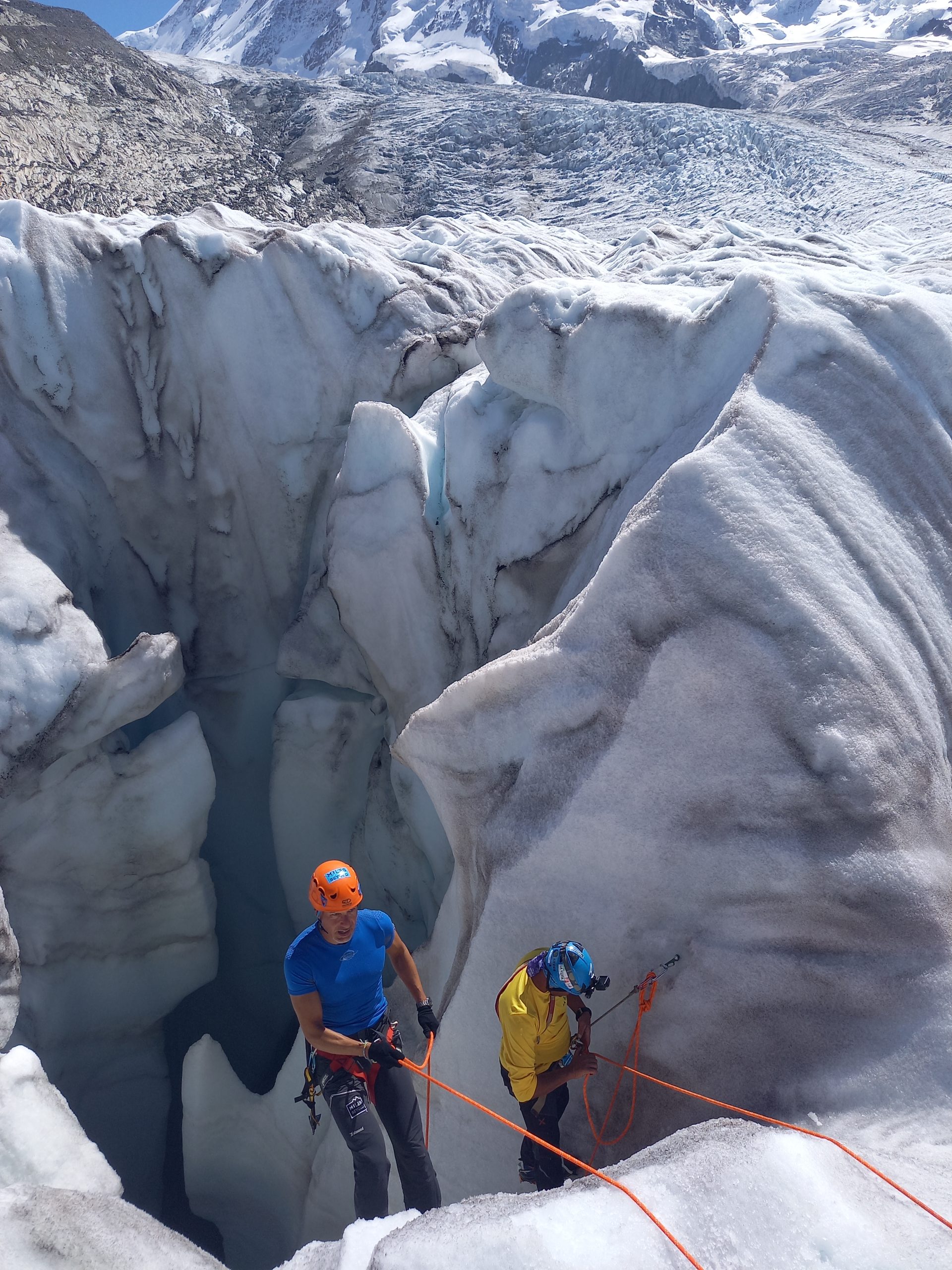
Abseiling into a mill on Gorner Glacier expedition. Credit: ESA
I ask if it is possible to try to abseil into the first part of the mill. Alessio and Paolo prepare a safety anchorage, then Alessio descends about six metres into the shaft, until he finds a platform – almost a balcony – on which to rest. From there, he tells us, it is possible to see almost all the way down, but it is not prudent to go further. When I lower myself down I understand why: from then on it would be impossible to stay dry, the water falls like a vertical waterfall and without specialised equipment – and in the absence of the correct preparation – I have to content myself with observing from where I am. Below me there is a phenomenal blade of ice, sculpted by the waters into the shape of the fin of a gigantic leviathan, or the throat of a demonic giant that swallows without escape anything that has the imprudence to get too close. The noise is deafening, such is the amount of dissolved water that pours relentlessly into the ice shaft… and anyway, I don’t feel I have much to say, because what I’m witnessing is perfectly clear: a glacier is dying, bleeding into nothingness. It’s time to head back to base camp.
Day 2 – around 14:30
I don’t know if it’s just an illusion, but the fact that I’m standing right under the northern face of Monte Rosa allows me to enjoy the snow’s transition from white to pink as the sun retreats. As it is, the light is already resting diagonally on the snow after lunch, when we set off on our second day’s hike and the highest part of the massif starts to reveal its signature hue.
We proceed northbound, moving between the rocks of the lateral moraine to look for the entrance to a contact cave – that is one formed in contact with the rocky base of the glacier – which can be safely explored.
The tunnel is almost perfectly cylindrical, and rather narrow, forcing me to bend down to get inside the icy tube. The cave, Alessio explains to me, is hollowed out by the double effect of the water digging from the surface and reaching the base of the glacier, turning into a river flowing over the rocks, and by the hot air entering from the outside that spreads in the three-dimensional meanders of the glacier structure.
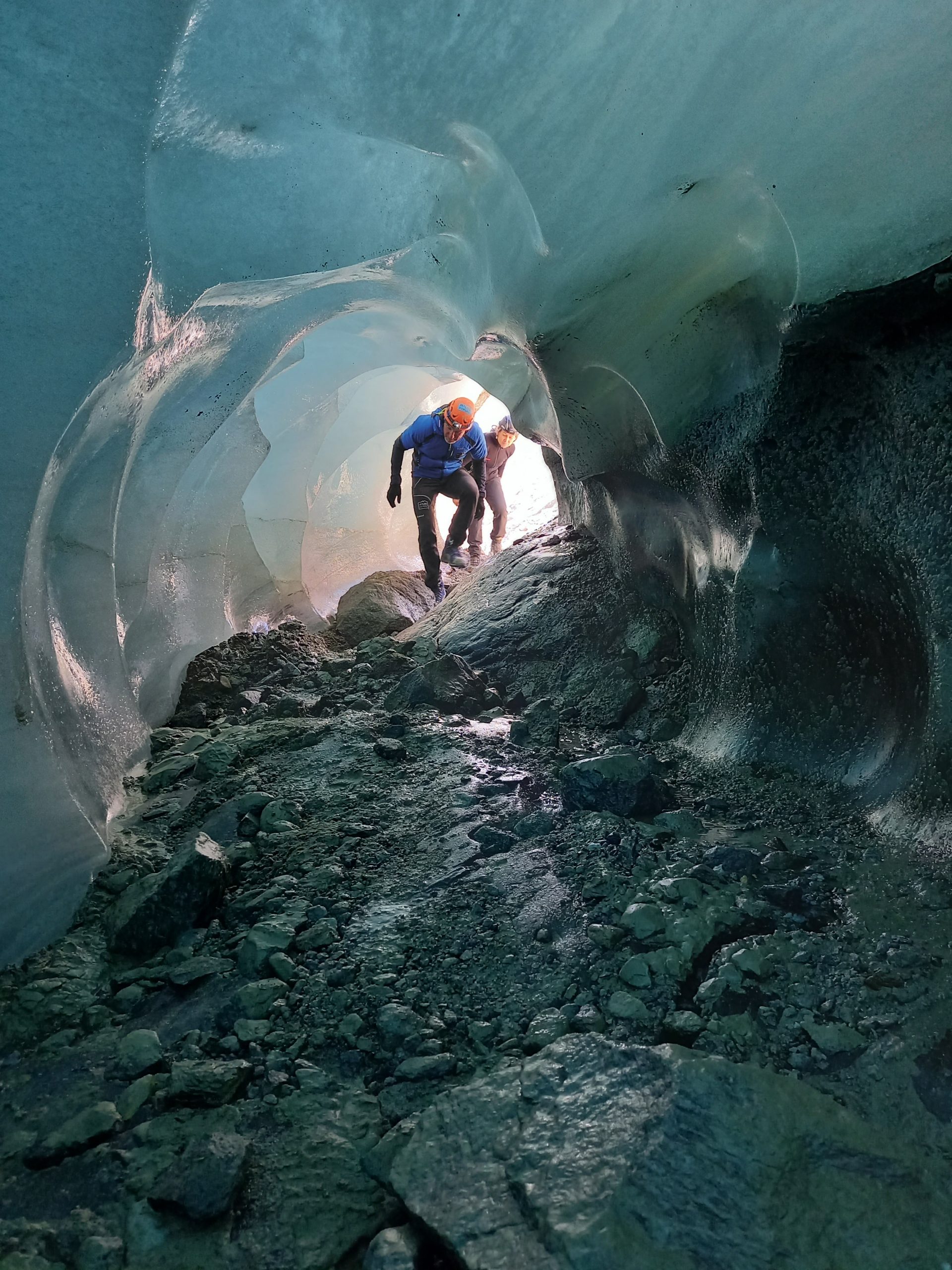
Expedition to the Gorner Glacier. Credit: ESA
At the entrance the wall of ice is thin, just enough to allow the light to penetrate, diffusing into a dreamlike blue; or rather, a blue that touches reality and gives it the same consistency of a dream. I catch myself touching the wall, as if to reassure myself – perfectly smooth, perfectly cold, illusorily solid.
Pushing inside, the vault widens to become a dome several metres high, with corridors radiating out in various directions, widening, narrowing, vanishing into darkness. Alessio has already explored the cave, which is relatively small, and shows me which corridors are viable. The main watercourse comes from an opening in the ice and disappears into another. Everywhere the constant dripping reminds us that we are in a temporary place, and that soon the vault will be too thin to support itself and will collapse, turning the cave into a crevasse. I enter the tunnels, driven only by curiosity and the desire to get a little lost. It is easy to lose one’s sense of direction in the absolute darkness of a cave, but here I find myself chasing the little bit of light that manages to filter through the metres of ice above me, and I manage to maintain a minimum of awareness. My eyes, and my mind, fill up with memories, shadows ranging from almost white to deep blue.
Perhaps it is its fragility that makes the fleeting, temporary beauty of this place all the more precious. I am aware that I will never have the opportunity to see it again. Every cave I have been able to explore gives me very strong emotions, and upon leaving I always promise myself that ‘one day’ I will return. A vain promise, and yet not impossible. Not here: this place is transient, and tomorrow it will already be different.
When I find myself outside, from a different outlet than the entrance, I follow the icy wall without hesitation to my left, to rejoin the others. We set off to return to base camp. The sun is already hiding behind the top of the highest mountains, although it will still be a few hours before it is completely dark…


